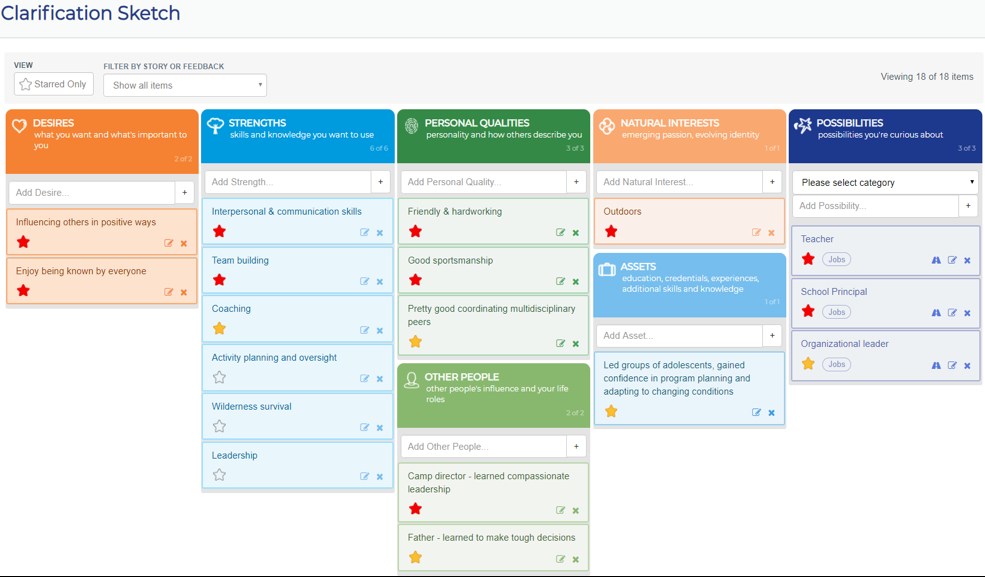Imagine a 26-year-old Justin Trudeau is sitting in front you. With a BA in literature from McGill and a recently completed BEd from UBC, he comes to you for career help, unsure of what to do next. Sure, he has some ideas – teacher? engineer? geographer? politics? – but he’s uncertain about all of them. Plus, he says he feels pressure from his parents, especially his father. What do you do?
Do you give him an interest inventory? A personality test? StrengthsFinder? Skip all that and just help fix his resume? Instead, you decide to ask him to tell you his story and see what happens when you place more value on personal narrative than assessment results.
We ask a common question during our OneLifeTools training for our evidence-based narrative framework: Do trainees use client stories or a narrative approach in their work? Most do. “I like to hear client’s stories,” one says. “Stories are valuable input,” another adds. But when pressed, career professionals admit their narrative approach is informal and inconsistent. What’s more, some might take notes, but clients don’t benefit from these because the practitioner files them away and they are forgotten.
“When pressed, career professionals admit their narrative approach is informal and inconsistent.”
We found that trainees were not using stories in a systematic way to gather and organize client desires, strengths, personal qualities, interests, influences and assets into a holistic, actionable and client-owned mosaic. An approach that sidesteps the need for traditional assessments – though integrates results when available – and focuses on client narratives instead, simply did not exist. The OneLifeTools-CareerCycles framework was created to fill that gap.
How the narrative approach works
A growing body of research supports our narrative method moving into evidence-based practice: seven journal articles and four textbook chapters, and now, a second outcome study, “Another story to tell: Outcomes of a single session narrative approach, blended with technology,” published in the January 2020 issue of the Canadian Journal of Career Development (CJCD). Our research finds that taking a narrative approach results in significant increases in clients’ clarity, confidence, optimism, organized thinking and two measures of career exploration.
Here’s how it works in an initial session, as discussed in the article. “The career professional uses a flexible structure to guide the hour to accomplish seven tasks:
- Elicit the client’s presenting question and initial career possibilities;
- explore career and life wants and dislikes;
- introduce the OneLifeTools/CareerCycles clarification-and-exploration framework;
- begin to use Online Storyteller to populate the client’s Clarification Sketch with initial items;
- reflect together with the client on one or more client experiences or stories while adding more content to Clarification Sketch;
- generate new and context-sensitive possibilities;
- and finally, recommend next steps.”
(An innovative working document, Clarification Sketch [see below] is the holistic mosaic into which the practitioner gathers and organizes client desires, strengths, personal qualities, interests, influences and assets.)
Every initial session includes the client sharing at least one story or narrative with the career professional. A client story may be any experience such as a job, role, volunteer opportunity or trip, among other activities. In initial sessions, the career professional elicits a story that the client feels good about, with the intention of increasing positive client affect, thus invoking Fredrickson’s (2001) “broaden and build” phenomenon. To gather and organize elements from client stories into a Clarification Sketch, open-ended questions are used such as: “What did you like about this story? What skills and knowledge did you use? How would people have described you? What interests were revealed? What possibilities come to mind as you reflect on this story?” We expand on this in an example session below.
The benefits of storytelling and storylistening
Using these open-ended questions, while simultaneously adding content to the client’s Clarification Sketch, builds practitioners’ storylistening skills. This approach provides immediate and valuable feedback to the client in a holistic and growing mosaic; clients find this not only satisfying, but then can turn these ideas into actionable possibilities. As one client cited in the article said, “I liked that by the end of the session I recognized that there is a light at the end of the tunnel. I can see the possibility of having clarity with my career path and that made me feel confident moving forward.”
Most clients reported that the initial session exceeded their expectations, and many mentioned how different it was from expectations because it was narrative and structured. Several clients also shared that they found Online Storyteller helpful in mapping out career conversations.
The rate at which clients return after an initial session for a paid program of five to eight sessions has reached 85% in some months, with the majority of months reaching above 50% (Franklin & Mackey, 2018).
Case vignette: Justin explores his options
Back in session with our client, Justin, let’s imagine asking him to tell us about his first paid job as a camp counsellor at Camp Ahmek, in order to learn more about him and generate future possibilities. As you read the dialogue, see our client’s Clarification Sketch in Figure 1, easily constructed during the interview by the career practitioner, moment-by-moment, in client’s presence.

CAREER PRACTITIONER (CP): Justin, what did you like about your camp counsellor experience?
CLIENT: Influencing others. I enjoyed being known by everyone.
CP: What did you dislike?
CLIENT: It got repetitive in August.
CP: What do you want more of because you disliked that repetitiveness?
CLIENT: More intellectual stimulation.
CP: What skills did you develop and enjoy using?
CLIENT: People AND communication skills. Team building. Coaching. Activity planning and oversight. Wilderness survival. Leadership
CP: How would peers describe you? Campers?
CLIENT: Friendly & hardworking. Good sport. Good at co-ordinating multidisciplinary peers.
CP: Who influenced you? What did you learn?
CLIENT: Camp director – I learned principled leadership and how to make tough decisions.
CP: What interests did you develop?
CLIENT: Love of the outdoors.
CP: What’s one line for your resume?
CLIENT: Led groups, gained confidence in program planning and adapting to changing conditions.
CP: What possibilities for your future come to mind as we reflect on this story?
CLIENT: Teacher. In future, school principal. Maybe some kind of leader?
The sketch below shows the data collected from just one story. When his Clarification Sketch is completed with more stories and feedback from allies, the client is invited to refine it into a brief Career Statement, which includes the most promising future possibilities. Then, within Online Storyteller, an Exploration Plan is constructed for each possibility.
Consider the tools you have been trusting to help clients. Are they still the best tools in 2020 given the increasing need to take into account context and lived experience? If you answered “no,” or “not sure,” we encourage you to consider trying and trusting systematic, structured and evidence-based tools to work with clients’ stories. If you trust the story, you are trusting the client to forge the path, with the narrative approach as the guiding light.
Want the best of CareerWise delivered to your inbox each week? Subscribe to our popular CareerWise Weekly newsletter to receive top news and views in career development every Tuesday.





